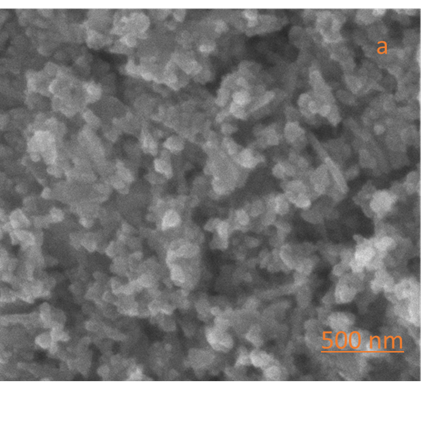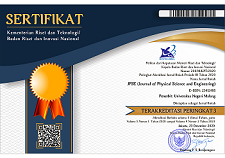
Green Synthaesis Nanomaterial Zinc Oxide with Anthocyanin Extract Hylocereus polyrhizus for DSSC Application
Abstract
Photovoltaic technology as an alternative to dye-sensitized third-generation solar cells is known as Dye-Sensitized Solar Cell (DSSC). DSSC is a device that can convert solar energy into electrical energy. Natural dye is used because it is relatively cheap and environmentally friendly. The type colour commonly used in DSSC are chlorophyll and anthocyanin. In this study the anthocyanin extract Hylocereus polyrhizus was used because it has a high absorption value. Nanoparticles ZnO is used because it has a relatively large energy gap value and can absorb sunlight optimally. The method used in this research is a spin coating, this method uses the procedure of making a thin film on the substrate. The characterizations were carried out using X-ray diffraction (XRD) to determine the crystal size of the ZnO nanoparticles, to know morphology nanoparticle can use scanning electron microscope (SEM), ultraviolet visible (UV-Vis) spectrometerer is used to determine the value of the band gap energy and solar cell simulator test to determine the efficiency value. The XRD result had a crystal size 30.74 nm. The SEM results that the shape of the particles is oval and homogeneous by agglomeration. The band gap value is 3.67 eV. The efficiency in the solar cell simulator test for the DSSC nanomaterial ZnO with anthocyanin extract Hylocereus polyrhizus was 0,29%.
Keywords
Full Text:
PDFReferences
U. Kaltsum, D. Nuraeni, W. Kurniawan, J. Saefan, E. Saptaningrum, and A. F. Kurniawan, “Efektivitas Penggunaan Elektroda Tembaga, Seng, Alumunium, dan Kaca Indium Timah Oksida (ITO) Pada Performa Dye Sensitized Solar Cells (DSSC) Pewarna Kulit Buah Naga Merah,” in Seminar Nasional Hasil Penelitian dan Pengabdian Kepada Masyarakat, 2021, pp. 195–203.
D. P. HANAVI, C. G. AFRILIA, L. SAFRIANI, and A. APRILIA, “Sintesis Zno Serbuk Dan Penggunaannya Sebagai Fotoanoda Pada Sel Surya Tersensitisasi Warna,” Jurnal Material dan Energi Indonesia, vol. 9, no. 01, pp. 44–52, 2019.
S. M. Siagian, “Analisis Semikonduktor zno: cu terhadap efisiensi dye Sensitized Solar cell menggunakan ekstrak alami,” Jurnal Elektro dan Mesin Terapan, vol. 7, no. 2, pp. 51–57, 2021.
E. Kouhestanian, M. Ranjbar, S. A. Mozaffari, and H. Salaramoli, “Investigating the effects of thickness on the performance of ZnO-based DSSC,” Progress in Color, Colorants and Coatings, vol. 14, no. 2, pp. 101–112, 2021.
M. Shakeel Ahmad, A. K. Pandey, and N. Abd Rahim, “Advancements in the development of TiO 2 photoanodes and its fabrication methods for dye sensitized solar cell (DSSC) applications. A review,” Renewable and Sustainable Energy Reviews, vol. 77, pp. 89–108, Sep. 2017, doi: 10.1016/j.rser.2017.03.129.
Y. Kusumawati, A. S. Hutama, D. V. Wellia, and R. Subagyo, “Natural resources for dye-sensitized solar cells,” Heliyon, vol. 7, no. 12, p. e08436, 2021.
A. N. Prasetya and D. Susanti, “Pengaruh Temperatur Kalsinasi pada Kaca FTO yang di-coating ZnO terhadap Efisiensi DSSC (Dye Sensitized Solar Cell) yang Menggunakan Dye dari Buah Terung Belanda (Solanum betaceum),” Jurnal Teknik ITS, vol. 2, no. 2, pp. F378–F383, 2013.
K.-C. Lin and C.-L. Chang, “Photo-Induced Electron Transfer from Dye or Quantum Dot to TiO2 Nanoparticles at Single Molecule Level,” in Solar Cells-Dye-Sensitized Devices, IntechOpen, 2011.
R. R. Sova and P. Setiarso, “Studi Elektrokimia Klorofil dan Antosianin Sebagai Fotosensitizer DSSC (Dye-Sensitized Solar Cell),” UJC, vol. 10, no. 2, pp. 191–199, May 2021, doi: 10.26740/ujc.v10n2.p191-199.
A. Daniswara, G. Raydiska, and Y. Timotius, “Strategi Implementasi Dye Sensitized Solar Cell (DSSC) di Indonesia,” JO, vol. 4, no. 2, Dec. 2020, doi: 10.30588/jo.v4i2.835.
S. Shalini, S. Prasanna, T. K. Mallick, and S. Senthilarasu, “Review on natural dye sensitized solar cells: Operation, materials and methods,” Renewable and Sustainable Energy Reviews, vol. 51, pp. 1306–1325, 2015.
S. Singh and V. Ramadesigan, Eds., Advances in Energy Research, Vol. 1: Selected Papers from ICAER 2017. in Springer Proceedings in Energy. Singapore: Springer Singapore, 2020. doi: 10.1007/978-981-15-2666-4.
M. J. García-Salinas and M. J. Ariza, “Optimizing a Simple Natural Dye Production Method for Dye-Sensitized Solar Cells: Examples for Betalain (Bougainvillea and Beetroot Extracts) and Anthocyanin Dyes,” Applied Sciences, vol. 9, no. 12, p. 2515, Jun. 2019, doi: 10.3390/app9122515.
M. A. Ridwan, E. Noor, M. S. Rusli, and Akhiruddin, “Fabrication of dye-sensitized solar cell using chlorophylls pigment from sargassum,” IOP Conf. Ser.: Earth Environ. Sci., vol. 144, p. 012039, Apr. 2018, doi: 10.1088/1755-1315/144/1/012039.
D. M. Sampaio, R. S. Babu, H. R. M. Costa, and A. L. F. de Barros, “Investigation of nanostructured TiO2 thin film coatings for DSSCs application using natural dye extracted from jabuticaba fruit as photosensitizers,” Ionics, vol. 25, no. 6, pp. 2893–2902, Jun. 2019, doi: 10.1007/s11581-018-2753-6.
D. Puspita, M. Sihombing, and K. Permata, “UJI TINGKAT KEMATANGAN BUAH MANGGA MENGGUNAKAN PIGMEN ANTOSIANIN DARI BUNGA TELANG (Clitoria ternatea),” florea, vol. 8, no. 2, p. 62, Nov. 2021, doi: 10.25273/florea.v8i2.11048.
E. R. Maramba Meha, W. Windarjoto, and H. Suyanto, “Analisis Hasil FTIR Dari Buah Kedondong dan Labu, Ubi Jalar dan Wortel Sebagai Bahan Alternatif Dye Sensitized Solar Cell (DSSC) Dengan Metode Multivariat,” BF, vol. 23, no. 2, p. 85, Aug. 2021, doi: 10.24843/BF.2022.v23.i02.p02.
W. Lopes De Almeida, N. S. Ferreira, F. S. Rodembusch, and V. Caldas De Sousa, “Study of structural and optical properties of ZnO nanoparticles synthesized by an eco-friendly tapioca-assisted route,” Materials Chemistry and Physics, vol. 258, p. 123926, Jan. 2021, doi: 10.1016/j.matchemphys.2020.123926.
H. Zhang, H. Li, and F. Qu, “Synthesis of ZrNiSn with high thermoelectric performance via a novel high-gravity combustion method,” Materials Letters, vol. 293, p. 129745, 2021.
A. Manikandan, J. J. Vijaya, S. Narayanan, and L. J. Kennedy, “Comparative Investigation of Structural, Optical Properties and Dye-Sensitized Solar Cell Applications of ZnO Nanostructures,” j nanosci nanotechnol, vol. 14, no. 3, pp. 2507–2514, Mar. 2014, doi: 10.1166/jnn.2014.8499.
M. Amjad et al., “Photovoltaic Properties of ZnO Films Co-Doped with Mn and La to Enhance Solar Cell Efficiency,” Nanomaterials, vol. 12, no. 7, p. 1057, Mar. 2022, doi: 10.3390/nano12071057.
Copyright (c) 2023 Mar’atus Sholikhah, Elok Putri Cindya Sari, Dea Berliana Ramadhani, Robi Kurniawan

This work is licensed under a Creative Commons Attribution-ShareAlike 4.0 International License.
This work is licensed under a Creative Commons Attribution-ShareAlike 4.0 International License



















